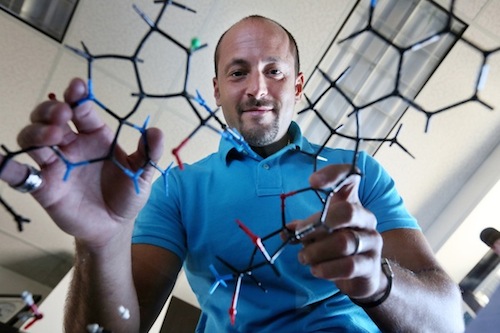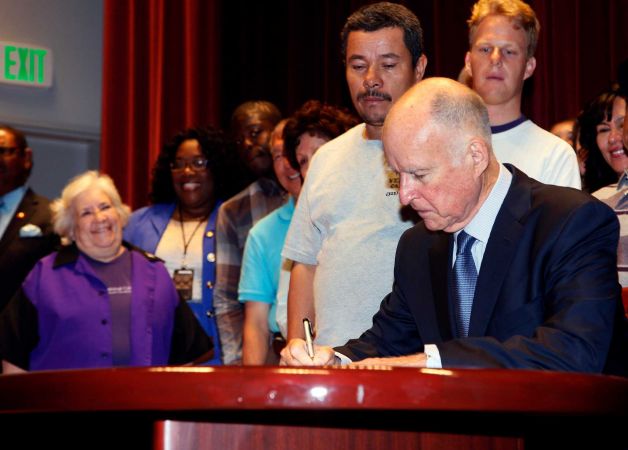Daily Business Report-Sept. 26, 2013
Gov. Jerry Brown signs legislation raising California’s minimum wage.
Governor Signs Legislation to Raise
Minimum Wage by 25 Percent
Gov. Jerry Brown signed legislation on Wednesday to raise California’s minimum wage by 25 percent, from $8 an hour to $10 an hour by 2016. The bill promises the first increase in California’s hourly minimum since 2008, when the minimum wage was raised 50 cents to $8. Assembly Bill 10, by Assemblyman Luis Alejo (D-Watsonville0, will raise the minimum wage from $8 to $9 an hour on July 1, 2014, and to $10 on Jan. 1, 2016. The bill was the only one of 38 bills designated by the California Chamber of Commerce as a “jobs killers” to make it out of the Legislature this year. The chamber and other business groups said raising the hourly minimum would unfairly increase business costs and jeopardize California’s economic recovery.
“After spearheading the effort to raise our state income tax to the highest in the nation, Gov. Brown vowed to be more prudent this year. Increasing the minimum wage by a staggering 25 percent violates that promise and will only cement California’s status as the worst place to start a business,” said John Kabateck, executive director of the California sector of the National Federation of Independent Business.
Maritime Industry Fights Back Against Barrio Logan Community Plan
San Diego’s maritime industry, unhappy with the City Council’s approval of a Barrio Logan Community Plan Update, announced plans to launch one or more citywide referendums “to protect the more than 46,000 San Diegans employed in this sector of the economy.” The plan update would create a buffer zone between residents and shipyards in which no new homes or industrial businesses could be built.
“We are extremely disappointed that the City Council voted to approve the plan and are convinced that this decision represents a dangerous first step toward the elimination of San Diego’s shipyards,” said Frederick Harris, president of NASSCO. “We have no choice but to protect the future of our industry by taking this aggressive action to prevent the adoption of this flawed plan.”
Industry representatives have formed a campaign called Protect our Jobs Coalition and they will be gathering signatures to force a public vote to overturn the council’s decision. Signature gathering is set to begin in early October. Around 34,000 voter signatures will be needed to force City Council to change it’s vote, or to put the referendum on a citywide ballot.
Councilman David Alvarez, a candidate for mayor, brokered the final plan, presenting it as a compromise. He said businesses would still be allowed to operate in the buffer zone, but they would have to first secure a CUP, or conditional use permit.

County Supervisors Look at Study Proposing
The Expansion of McLellan-Palomar Airport
County Supervisors voted to receive a feasibility study on extending the runway of the McLellan-Palomar Airport in that would allow corporate jets to fly from Carlsbad nonstop to the East Coast and China, KPBS reports. The expansion would extend the runway east by 900 feet over an old landfill. Supervisors declined to use the word “accept,” which might have implied they agreed to its proposed plan.
Carlsbad is nurturing a cluster of biotech companies, and hopes providing easier international connections will encourage the growth of this biotech hub. Currently the only commercial airline that flies in and out of Palomar Airport is United Express, which flies 15 shuttles a day to Los Angeles. Another private airline that hopes to operate out of the airport, California Pacific Airlines, was recently denied an FAA license.
Construction of the extension, and a safety apron at the west end to stop airplane overruns, would cost more than $90 million. Supervisor Bill Horn said some of that could be funded with FAA grants, but more than $30 million would need to be raised locally.
The county’s airport director, Peter Drinkwater, estimated the county has already invested about $75 million in upgrading the runway in recent years, and private corporations have invested $130 million.
The $650,000 feasibility study estimates a 900 foot runway extension would generate an extra $160 million over 20 years in economic benefits to the region.
The county plans to fold the conclusions of the feasibility study into a 20- year master plan for McClellan Palomar Airport, and will accept public input. That process could end in 2015.

Multi-Billion-Dollar Urban Center Planned for South County
The beginning of a multi-billion-dollar community in Chula Vista — with multi-family residences, office and retail developments and promenades and parks — was begun today by McMillin Communities. At its completion in about 20 years, Millenia will have a population of about 8,500, according to the developer. It will be equivalent to about 80 city blocks, and is fully entitled with plans for 3,000 multi-family residences, 2 million square feet of Class A office space on 30 acres, 1.5 million square feet of retail, hospitality, civic and mixed-use projects, six themed urban parks and a variety of tree-lined promenades, casual gathering places, bikeways, and plazas. It has been designated a Smart Growth Urban Center by the San Diego Association of Governments.
“We envision Millenia becoming the future city center of South County and the epicenter of the emerging San Diego/Tijuana mega region,” said Scott McMillin, chairman of The Corky McMillin Companies. “It is ideally located near the U.S. Olympic Training Center, only four miles from the Otay Mesa Port of Entry and the planned cross-border terminal, and just 20 miles from Downtown San Diego and Lindberg Field,” he said.
Interior Designers Chapter Elects Kimberly Hansen as President

Kimberley B. Hansen, owner of Burgess Hansen Design of San Diego, has been elected president of the San Diego chapter of the American Society of Interior Designers fro the 2013-14 term. Hansen specializes in the design of custom residences and commercial properties. Before establishing her own firm in 1999, she worked for a Los Angeles design firm, in retail display, retail management and government procurement contracting. Her work has been published in San Diego Home/Garden Lifestyles and U-T San Diego and she has been honored for her commercial design with a Design Excellence Award from the ASID San Diego chapter. She earned a bachelor’s degree in clothing, textiles and merchandising from San Diego State University.
Boyd Contreras Announces Promotion
The Boyd Contreras APC law firm has promoted Thomas Georgianna to the position of managing associate for the civil litigation division and Chapter 11 bankruptcy division. Georgianna oversees these divisions across their multiple offices in San Diego, Orange County and Los Angeles. Georgianna is a graduate of Point Loma Nazarene University and earned his JD degree from Brooklyn Law School.
Human Resources Vice Chancellor Named

Marsha Edwards has joined the Grossmont-Cuyamaca Community College District as vice chancellor for human resources. Edwards is a 22-year veteran if the education field. Before joining the district, Edwards had worked since 2010 as the human resources dean for Clackamas Community College, a 38,000-student, three-campus college based in Oregon City. She also worked during two separate stretches for Linn-Benton Community College, a 23,000-student campus in Albany, first as the employment services manager in the late ‘90s and early 2000s, then as the human resources director for four years prior to her job at Clackamas. She has also held HR management positions with the cities of Lebanon and Portland, Ore.

Scripps Research Institute Chemist Named MacArthur Fellow
Chemist Phil S. Baran of The Scripps Research Institute has won a 2013 MacArthur Fellowship — sometimes called a “genius grant” — and will receive a $625,000 fellowship over fie years from the John D. and Catherine T. MacArthur Foundation. The grant comes with no specific obligations or reporting requirements. Baran’s contributions have been in the area of synthetic organic chemistry, where he has pushed boundaries with innovative solutions to synthetic problems. With members of his team at TSRI, he has developed new techniques that dramatically reduce the time, complexity and cost of synthesizing natural products with pharmaceutical potential for conditions including cancer, heart disease and vision loss.




